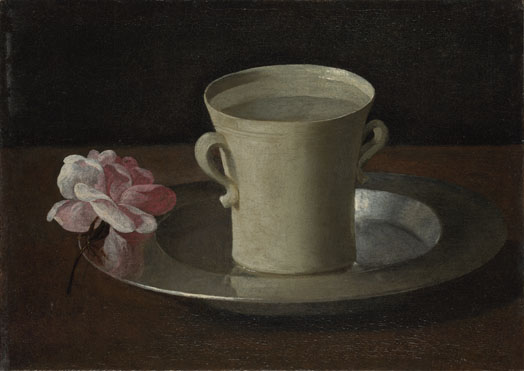Continuing our series looking at great paintings housed in London’s National Gallery…
The National Gallery is not short of big, attention-grabbing showpieces, but there are also small, unassuming pictures that can stop you in your tracks and compel your attention just as effectively.
One that I often return to is this still life, A Cup of Water and a Rose, painted around 1630 by the Spanish artist Francisco de Zurbaran, best known for his rather harsh and austere paintings of saints and penitents.
A Cup of Water and a Rose has, despite its small scale, a kind of monumental stillness. That earthenware cup, that silver plate, that rose, all are intensely there and intensely themselves. Dramatised by the deep darkness of the background and the fall of light from somewhere to the left of the picture space, the objects stand there, quietly commanding our attention.
They are painted with a mesmeric verismilitude worthy of Velazquez (or Vermeer) – the play of reflected light on the water in the cup and on the silver plate below is especially beautifully rendered – but this is no trompe l’oeil trickery. The cup, the rose, the plate all hint at deeper meanings. There is almost certainly an element of religious symbolism, but perhaps the deepest meaning, and the deepest mystery, of these objects is simply that they are themselves.
As Oscar Wilde said, ‘The true mystery of the world is the visible.’









I have a strong, tantalising urge to pop that rose in the glass of water, to give it a drink.
yes the water does look tantalisingly refreshing. I love the high sheen on the silver plate. The artist has managed to make the flower seem so dainty and light in comparison to the heaviness of the other two objects
There’s definitely a religious quality to it. It looks like an offering (the Catholic host on a silver plate etc…)
Thank you very much for this posting. I’ve felt exactly that quality of stillness in other works by Zurburan and I’d guess this must be one of the most difficult things for an artist or writer to convey in any medium. Get it wrong and you are left with something crude and flat, unable to “hint at deeper meanings”.This little painting and others which match it in accomplishment always foil my attempts to find religious symbolism in them because that quality of “intensely there” which you mention quietly tells me that, whatever I might think I’ve found, reality is beyond religion.
I also love the sheen and patina of the plate, but also the reflections of both the cup and the rose in the plate, particularly the delicacy of the rose reflection.
Nige, although I know nothing about still life, but this painting seems to reflect rather a lot of things: our mortality/salvation/good/evil/life/death/natural/unnatural/futility/hope etc etc etc. And the curious selection of inanimate objects represents most of the senses – the only thing missing is Vivaldi’s C major mandolin concerto c/o Mahlerman
Ps excuse typos.
It reminds me somehow of a Shane Meadows film: there is beauty and meaning in ordinary things, but it takes a really exceptional artist to show them.